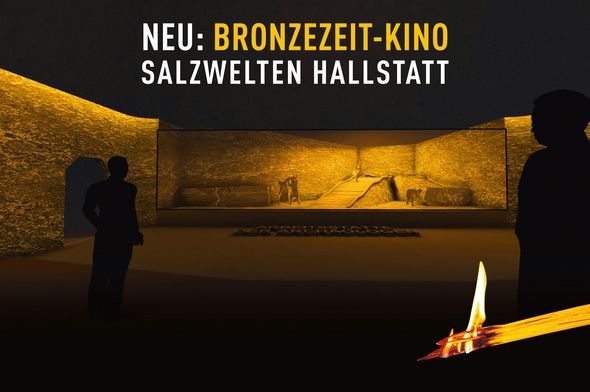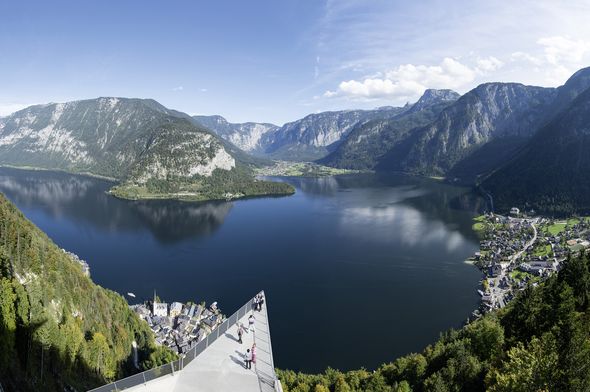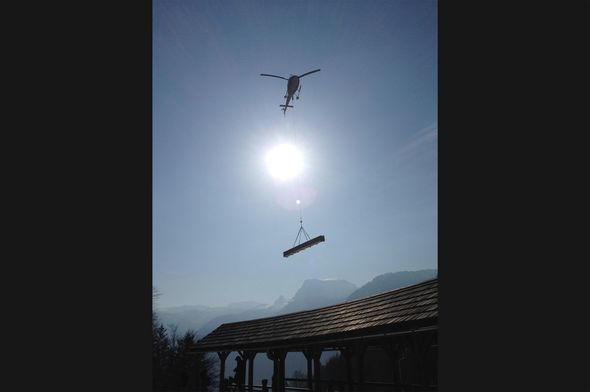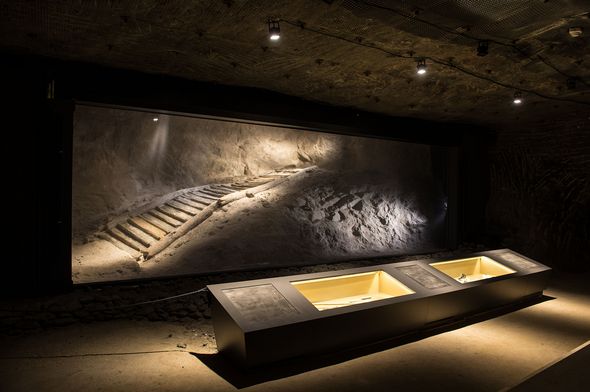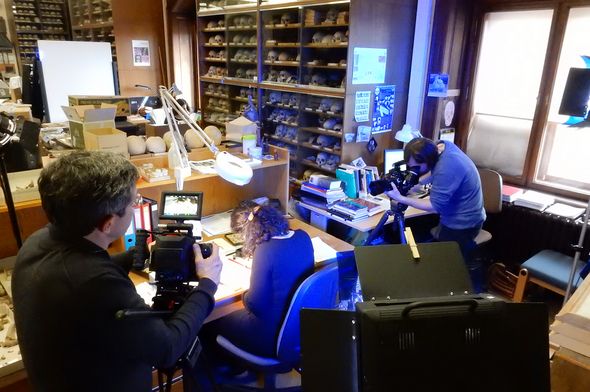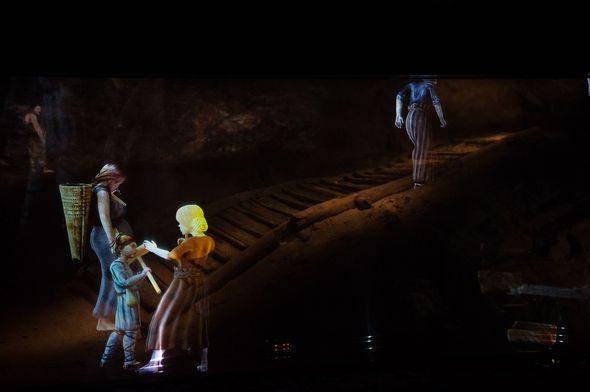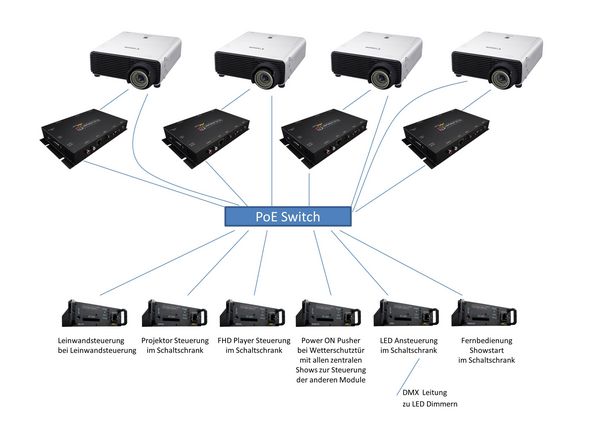In April 2015 the salt mines in Hallstatt, Altaussee and Hallein opened up their tunnels to visitors again. New highlights were created for the approx. 420,000 guests who visit the salt mines in the Salzkammergut each year. Using multimedia and infotainment the salt mines present 7,000 years of cultural history at the original historical site.
The Bronze Age cinema is a worldwide novelty which has been open daily at the salt mine in Hallstatt since the beginning of the season. The story of Udlo, a Bronze Age boy from Hallstatt is told vividly and projected onto a Magnum screen in the latest 4K HD quality. The Bronze Age cinema is given special historic expressiveness by the integration of one of the most valuable archaeological objects – the oldest wooden staircase in Europe, which after 10 years of research by a team from the prehistoric department of Vienna’s Museum of Natural History has been “embedded” in the salt mine again and forms the central point of the stage.
Production and design of the Bronze Age cinema
Realizing a cinema projection 400 metres underground and linking this to a valuable archaeological object is an enormous challenge. Due to the plasticity properties of the salt mine and the limited space a special concept was necessary for the modern and scientifically-sound production to be implemented in a narrow tunnel. The team from Scenomedia was commissioned with the creation and implementation of the Bronze Age cinema.
The production in the Bronze Age cinema – an experience
The entire show block in the Bronze Age cinema, deep within the Hallstatt salt mine is about 10 minutes long. It starts with a documentary projected onto a 9 x 3 metre Magnum motorized screen about the work of the archaeologists on the discovered object. After the motorized screen has been unrolled a 4k HD animated film follows telling the story of Udlo, a boy from Hallstatt who worked in the mine with his clan in the Bronze Age. A laser film with a grid structure is used as the projection screen for the animated film so that the original showpiece – Europe’s oldest wooden staircase – can be seen in the background. 3,000 years back in the three-dimensional journey through time the projection and the original merge – a symbiosis which is unique throughout the world. The cavern has room for about 70 visitors per performance and at the end they can admire a display case with prehistoric artefacts.
The mine and the showpiece:
Two particular challenges. Protected behind a second impermeable transparent film the oldest wooden staircase in Europe forms the stage for the production – an undertaking which was extremely difficult due to the strict monument protection constraints. Only TÜV-tested materials and those consistently certified could be used for the installation. In addition to the laser screen a special transparent protective film, which had been thoroughly checked by the Fraunhofer Institute in Munich, was stretched over an area of 9 x 3 metres as sealing. The usual casing of glass could not be used for the 8 metre long staircase – as it was too large for the narrow tunnel in the mine. The delivery of the large motorized screen was just as unusual. Due to the difficult terrain the screen was flown by helicopter to the tunnel entrance and manoeuvered through the narrow passageways with considerable skill.
The technicians were confronted by a further challenge as a result of the plasticity properties of the mine. The soft salt rock and the surrounding Dachstein limestone respectively cause a shift of several centimetres in the mountain each year. For this reason all the projectors were connected to one another via a truss traverse. Changes can be compensated using adjusting screws and screens can be restretched. The logistics were also a challenge. The 9m wide Stumpfl motorized screen had to be flown up the mountain and manoeuvred through the narrow tunnel to its final destination.
From 6k to 4k and short throw projection
From 6k to 4k and short throw projection
For the specialists from Scenomedia there was no doubt right from the beginning that all the footage shot during the filming of the documentary or the animated film was to be of the highest resolution possible. Full 6k with a resolution of 6144 x 3072 pixels was recorded using the latest Red Epic Dragon cameras. As the story of Udlo dispenses with bright colours in favour of more realistic ones, the production requires a higher resolution and image sharpness. In addition, zooms filmed in 6k can be extracted during post-production without any loss of quality. In the final result the decision was taken to use a state of the art 4k projection. The 4096 x 2304 pixels are necessary for accurate image display on the grid screen and optimal for colour accuracy due to the dark environment in the mountain. In total 32 hours of computational power were necessary to convert 2 minutes of animation sequences into the final version.
The installation in the cavern, which had been specially detonated, also required an unusual solution and was implemented together with AV Stumpfl’s multi-award winning projection and media specialists. The objective was to keep detonations in the mountain to a minimum while still achieving maximum cinema projection on a 9 or 10 x 3 metre screen. As the distance between the beamers and the projection screen is only 2.5 metres 3 HD Canon XEED WUX400ST short throw projectors were installed and their contents merged into a multi-display projection. In this innovative short throw projection each beamer covers one third of the screen completely seamlessly. A fourth beamer projects onto the rock face in the background in order to create the three-dimensional effect. The content and the show were arranged using Wings Vioso and the connection of all AV components was programmed using the AVIO system. The interfaces were controlled via Wings IObox. All the components of the show are connected in the network. The PoE switch also provides the power supply for the IOboxes. This facilitates wiring efforts considerably and guarantees that each interface (e.g. activation of the LED lighting by DMX) is available for programming and control. The content is played back on Stumpfl FHD Players, which are frame-accurate in playing the respective image content. Bose’s weather resistant sound system was deliberately chosen for optimal acoustics in the cavern (2x Bose MA12EX with MB12WR subwoofer).
According to Andreas Scheucher, Managing Director of Scenomedia, “We were allowed to look over the shoulders of the researchers for a period of two years for the Bronze Age cinema. The authentic details and the interaction with the original wooden staircase make the production unique”.
www.salzwelten.at
www.nhm-wien.ac.at/hallstatt
www.scenomedia.at
